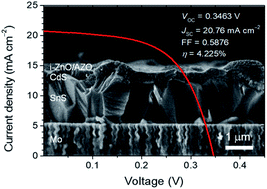Achieving over 4% efficiency for SnS/CdS thin-film solar cells by improving the heterojunction interface quality†
Abstract
The highest efficiency of 4.225% for vapor-transport-deposited (VTD) SnS absorber/CdS heterojunction solar cells with good long-term stability over two years is reported. These improved characteristics are attributed to the reduction in interface defects of the heterojunction, which can occur either during the deposition of transparent electrodes or direct annealing of the SnS/CdS heterojunction at 300 °C. The enhanced heterojunction interface quality is supported by the substantially reduced dark saturation current density and shunt conductance of the fabricated devices measured under dark conditions. Although the SnS/CdS device exhibits efficiency over 4%, significant short-circuit current loss mainly due to recombination was revealed by quantum efficiency and optical analysis. Admittance analysis shows the presence of numerous defect densities of Sn and S vacancies (>1017 cm−3) in the VTD-grown SnS absorber. Minimizing bulk and interface defect densities of SnS absorbers will be a key issue in achieving high efficiency (>5%) of SnS-based thin-film solar cells.



 Please wait while we load your content...
Please wait while we load your content...